

Hiei 1914

Hiei 1941
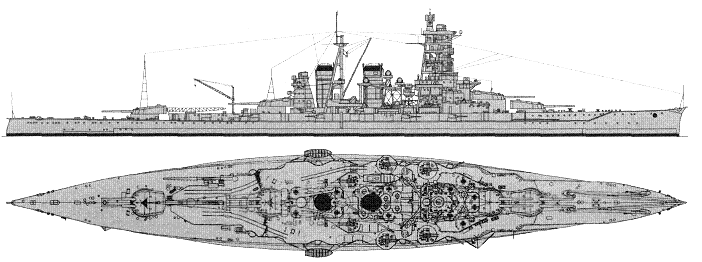
Kongo 1944

Haruna 1944
| Name | No | Yard No | Builder | Laid down | Launched | Comp | Fate |
| 金剛 [Kongo] | 414 | Vickers, Barrow, UK | 17.1.1911 | 18.5.1912 | 16.8.1913 | sunk 21.11.1944 | |
| 比叡 [Hiei] | Yokosuka K K | 4.11.1911 | 21.11.1912 | 4.8.1914 | sunk 13.11.1942 | ||
| 霧島 [Kirishima] | 225 | Mitsubishi, Nagasaki | 17.3.1912 | 1.12.1913 | 19.4.1915 | sunk 15.11.1942 | |
| 榛名 [Haruna] | Kawasaki, Kobe | 16.3.1912 | 14.12.1913 | 19.4.1915 | sunk 28.7.1945 |
| Data variant | as completed |
|
Displacement normal, t |
27500 |
|
Displacement full, t |
32200 |
|
Length, m |
212.1 wl 214.5 oa |
|
Breadth, m |
28.0 |
|
Draught, m |
8.40 |
|
No of shafts |
4 |
|
Machinery |
Kongo, Hiei, Kirishima: 4 Parsons steam turbines, 36 Yarrow boilers Haruna: 4 Brown-Curtis steam turbines, 36 Yarrow boilers |
|
Power, h. p. |
64000 |
|
Max speed, kts |
27.5 |
|
Fuel, t |
coal 4200 + oil 1000 |
| Endurance, nm(kts) | 8000(14) |
|
Armour, mm |
belt: 203 - 76, bulkheads: 203 - 127, deck: 57 - 38, barbettes: 254, turrets: 229 - 76, casemates: 152, CT: 254 |
|
Armament |
Kongo: 4 x 2 - 356/45 43-shiki, 16 x 1 - 152/50 41-shiki, 16 x 1 - 76/40 41-shiki, 8 - 533 TT (beam) others: 4 x 2 - 356/45 41-shiki, 16 x 1 - 152/50 41-shiki, 8 x 1 - 76/40 41-shiki, 8 - 533 TT (beam) |
|
Complement |
Kongo: 1201 others: 1221 |
Project history: The history of designing of Kongo class goes back to 1909 when the project of 19000t battlecruisers with 305mm guns has been prepared. Though means have already been assigned, this design was remained non-realised: news from Britain about new "superdreadnoughts" battlecruisers of Lion class with 343mm guns have arrived. Not wishing to appear in a role of a lagging behind, Japanese designers have started cardinal redesigning of the project, however absence of sufficient experience has compelled to be converted to British designers for the technical help. It was promoted by concluded in 1902 alliance between Japan and UK. Leading British shipyards have shown the big interest in cooperation as it was obvious, that the building of so large ship in Japan while is impracticable and the order for building will get to the designer. Japanese have preferred Vickers, with which in October, 1910 they have signed the contract. As starting point at designing of Kongo Lion has served design project have significantly redesigned in Japanese Naval Technical department. The most perfect (according to dominating sights) battlecruiser in the world became a result of joint efforts of the customer and the builder. After a lead ship built in the UK, three more units were laid down in Japan. At building of the first of them, Hiei, about 30% of materials and equipment have ordered abroad, and for two latter domestic materials were used only.
Hull of Kongo, in comparison with Lion, became wider on 1.7m, that allowed to achieve more rational machinery and artillery arrangement: No3 gun turret was transferred from amidships to a stern, having interchanged places with stern boilers group (on Lion it has been cramped between two groups of boiler rooms). It has ensured much more favourable angles of training. Except other arrangement, machinery essentially did not differ from Lion's.
Vertical protection, in comparison with a prototype, has been a little deadened: main belt became more thin, 203 against 229mm. At ship ends it was 76mm. Over the main belt a side was protected by 152mm armour. More thin vertical protection at that time admitted by Japanese justified as the increase in a distance of battle and, as consequence, more steep fall of shells was expected.
Ship protection: 3.8m-high main belt extended from No1 to No4 barbettes and had 203mm thickness between barbettes. It closed by 152-127mm bulkhead abreast No1 barbette and 203-152mm bulkhead abreast No4 barbette. Ship ends from end barbettes to ship ends were protected by 76mm belt. Upper 152mm belt extended from main belt to upper deck and from No1 to No4 barbette. It was closed by 152mm bulkheads. Casemates had also 152mm armor. Main 19mm deck connected with lower edge of main belt by 19mm slopes. Forecastle deck and upper deck aft from No3 barbette had 38mm protection.
Ship protection after 1928-1931 modernization: 3.8m-high main belt extended from No1 to No4 barbettes and had 203mm thickness between barbettes. It was closed by 152-127mm bulkhead abreast No1 barbette and 203-152mm bulkhead abreast No4 barbette. Ship ends from end barbettes to ship ends were protected by 76mm belt. Upper 152mm belt extended from main belt to upper deck and from No1 to No4 barbette. It was closed by 152mm bulkheads. Casemates had also 152mm armor. Main 19mm deck was connected with lower edge of main belt by 19mm slopes. Its thickness increased to 80mm over machinery and 120mm over magazines. Forecastle deck and upper deck aft from No3 barbette had 38mm protection. Underwater protection could resist exploding of 200kg TNT.
Ship protection after 1934-1940 modernization: 3.8m-high main belt extended from No1 to No4 barbettes and had 203mm thickness between barbettes. It was closed by 152-127mm bulkhead abreast No1 barbette and 203-152mm bulkhead abreast No4 barbette. Ship ends outside end barbettes were protected by 76mm belt. Upper 152mm belt extended from main belt to upper deck and from No1 to No4 barbette. It was closed by 152mm bulkheads. Casemates had also 152mm armor. Main 19mm deck connected with lower edge of main belt by 19mm slopes. Its thickness increased to 80mm over machinery and 152mm over magazines. Forecastle deck and upper deck aft from No3 barbette had 38mm protection. There was 51-40mm anti-torpedo longitudinal bulkhead.
Modernizations: 1917, Kongo: + flying-off platform (temporarily, for tests only)
1918, Kongo: - 16 x 1 - 76/40; + 4 x 1 - 76/40 3-shiki AA
1918, Hiei, Haruna, Kirishima: - 8 x 1 - 76/40; + 4 x 1 - 76/40 3-shiki AA
1923 - 1925, all: maximal angle of main gun elevation was increased from 25° to 33°; + 3 x 1 - 76/40 3-shiki AA
(3/1924 - 7.1928, Yokosuka K K), Haruna; (3/1927 - 3.1930, Kure K K), Kirishima; (9/1929 - 3.1931, Yokosuka K K), Kongo: main deck was strengthened to 80mm over machinery and 120mm over magazines. Thickness of turrets crowns was increased to 152mm. Barbettes under main deck were strengthened to 152-140 mm. Bulges were fitted, breadth rose to 29.3m. 4 TT were removed. Boilers were replaced by new ones. Data was as given in the table.
| Data variant | 1928-1931 modernization |
|
Displacement standard, t |
29330 |
|
Displacement full, t |
31785 |
|
Length, m |
212.1 wl 215.2 oa |
|
Breadth, m |
29.3 |
|
Draught, m |
8.65 |
|
No of shafts |
4 |
|
Machinery |
Kongo, Kirishima: 4 Parsons steam turbines, 10 Kampon boilers Haruna: 4 Brown-Curtis steam turbines, 16 Kampon boilers |
|
Power, h. p. |
64000 |
|
Max speed, kts |
25.9 |
|
Fuel, t |
coal 2661 + oil 3292 |
|
Endurance, nm(kts) |
10000(18) |
|
Armour, mm |
belt: 203 - 76, bulkheads: 203 - 127, deck: 57 - 38, over magazines: 120, over machinery: 80, barbettes: 305, turrets: 229 - 152, casemates: 152, CT: 254 |
|
Armament |
Kongo: 4 x 2 - 356/45 43-shiki, 16 x 1 - 152/50 41-shiki, 7 x 1 - 76/40 3-shiki, 4 - 533 TT (beam) Haruna, Kirishima: 4 x 2 - 356/45 41-shiki, 16 x 1 - 152/50 41-shiki, 7 x 1 - 76/40 3-shiki, 4 - 533 TT (beam) |
|
Complement |
1118 |
(10/1929 - 12.1932, Kure K K), Hiei: Main and upper belts were removed, 25 boilers were removed (13800hp, 18kts), fore funnel was removed; - 1 x 2 - 356/45 (No4), 16 x 1 - 152/50, 4 - 533 TT; Standard displacement was 19500t with 6.3m draught.
1932 - 1933, Kongo, Haruna, Kirishima: - 7 x 1 - 76/40; + 4 x 2 - 127/40 89-shiki, 4 x 1 - 40/62 "HI" 91-shiki, 8 x 1 - 13.2/76, 1 catapult, 3 seaplanes (E2N1)
(8/1933 - 9.1934, Kure K K) Haruna; (11/1934 - 6.1936, Sasebo K K) Kirishima; (6/1935 - 1.1937, Yokosuka K K) Kongo; (4/1936 - 1.1940, Kure K K) Hiei: Fully new machinery was fitted, its power doubled. Hull was lengthened, superstructures reconstructed. Main gun elevation angle was increased to 43° and secondary guns from 15° to 30°. AA armament was modernized. Horizontal protection of magazines increased to 152mm. Underwater protection was reconstructed, thickness of longitudinal bulkhead was 51-40mm. Data was as follows:
| Data variant | 1934-1940 modernization |
|
Displacement standard, t |
Kongo: 31720 Hiei: 32350 Kirishima: 31980 Haruna: 32156 |
|
Displacement full, t |
36601 |
|
Length, m |
219.6 wl 222.1 oa |
|
Breadth, m |
29.3 |
|
Draught, m |
9.72 |
|
No of shafts |
4 |
|
Machinery |
Kongo, Kirishima: 4 sets Kampon geared steam turbines, 8 Kampon boilers Haruna, Hiei: 4 sets Kampon geared steam turbines, 11 Kampon boilers |
|
Power, h. p. |
136000 |
|
Max speed, kts |
30.5 |
|
Fuel, t |
oil 6330 |
| Endurance, nm(kts) | 10000(18) |
|
Armour, mm |
belt: 203 - 76, bulkheads: 203 - 127, deck: 57 - 38, over magazines: 152, over machinery: 80, barbettes: 305, turrets: 229 - 152, casemates: 152, CT: 254 |
|
Armament |
Kongo: 4 x 2 - 356/45 43-shiki, 14 x 1 - 152/50 41-shiki, 4 x 2 - 127/40 89-shiki, 10 x 2 - 25/60 96-shiki, 1 catapult, 3 seaplanes (E7K2) Kirishima, Hiei: 4 x 2 - 356/45 41-shiki, 14 x 1 - 152/50 41-shiki, 4 x 2 - 127/40 89-shiki, 10 x 2 - 25/60 96-shiki, 1 catapult, 3 seaplanes (E7K2) Haruna: 4 x 2 - 356/45 41-shiki, 14 x 1 - 152/50 41-shiki, 4 x 2 - 127/40 89-shiki, 4 x 2 - 13.2/76, 1 catapult, 3 seaplanes (E7K2) |
|
Complement |
1437 |
1936, Haruna: - 4 x 2 - 13.2/76; + 10 x 2 - 25/60 96-shiki
8/1942, Kongo: + 21-go radar
3/1943, Kongo: steering gear compartments sides and roofs were additionally protected by concrete; - 2 x 1 - 152/50; + 2 x 3 - 25/60 96-shiki
3/1943, Haruna: steering gear compartments sides and roofs were additionally protected by concrete; - 6 x 1 - 152/50; + 2 x 2 - 127/40 89-shiki, 7 x 2 - 25/60 96-shiki, 1-shiki 2-go radar
2/1944, Kongo: - 4 x 1 - 152/50, 2 x 2 - 25/60; + 2 x 2 - 127/40 89-shiki, 4 x 3 - 25/60 96-shiki
6/1944, Haruna: - 15 x 2 - 25/60; + 30 x 3 - 25/60 96-shiki, 6 x 1 - 25/60 96-shiki, 3-shiki 1-go radar
7/1944, Kongo: + 10 x 3 - 25/60 96-shiki, 40 x 1 - 25/60 96-shiki, 2-shiki 2-go, 3-shiki 1-go radars
1/1945, Haruna: + 17 x 1 - 25/60 96-shiki
Naval service: In 1917 Haruna received battle damages, having stricken by a mine layd by German auxiliary cruiser Wolf.
Hiei in night battle at Sawo island 12-13.11.1942 (1st battle at Guadalcanal) was badly damaged by gunfire of American cruisers San Francisco, Portland and destroyers (about 85 hits of different shells, including nearby 50 203mm). At withdrawal at day she was attacked by American aircraft (Enterprise (1 454kg bomb and 2 torpedoes) and Saratoga (2 torpedoes) air groups, B-17 bomber (227kg bomb) and USMC aircraft (3 454kg bombs)) and received new damages, lost speed and sunk by escort. Kirishima in night battle at Sawo island 12-13.11.1942 was easily damaged by 203mm shell. At night 14-15.11.1942 (2nd battle at Guadalcanal) she was hardly damaged by gunfire of American battleships Washington and South Dakota (nine hits of 406mm shells and about 40 of 127mm from close distance) and has sunk off Sawo island in the morning. Kongo 21.11.1944 en route to Japan was torpedoed in N part of Formosa strait by American submarine Sealion (under different versions, has got from one to three torpedoes). In two hours she has blown up and sunk. Haruna 13.6.1944 was damaged by American carrier aircraft (2 direct bomb hits to a stern, 2 near misses). 24 and 28.7.1945 during American carrier aircraft raids of TF.38 to Kure she received 3 and 9 direct hits respectively and sunk on shallow water. After war she was salvaged and scrapped.
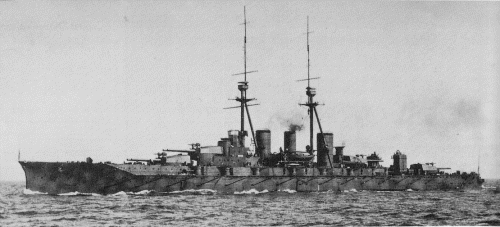
Kongo 1913
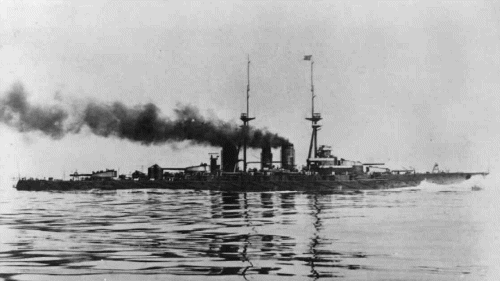
Hiei

Hiei 1928
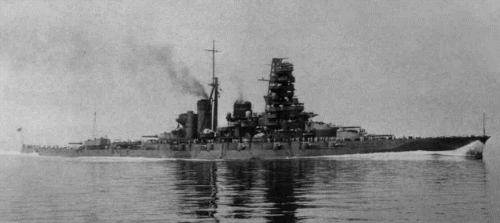
Haruna
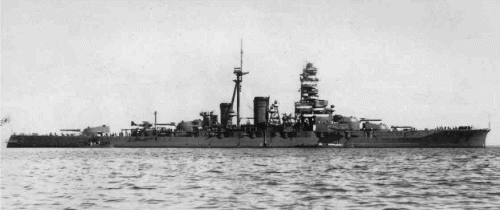
Kirishima
Many thanks to Wolfgang Stöhr for additional information on this page.
© Ivan Gogin, 2008-14